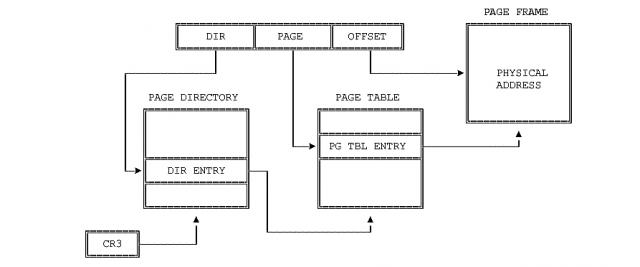Paging vs. Segmentation05/21/2009
The title of this note is confusing; it suggests that Segmentation and Paging are mutually exclusive but that is not entirely correct. Those refer of alternate methods for managing virtual memory; however, modern processors such as Intel x86 provide support for both and is opt to the Operating System to use the one, the other or both.
Before entering into details, lets state that there are two ways (or "models") of seeing the virtual memory space: Linear and Segmented.
In the Linear Model, the virtual memory space is seen as an array of 2^32 (4G) bytes. To address it, a 32 bits pointer is all we need. The address provided this way is called a "Linear Address".
In the Segmented model the virtual memory space is divided into 2^16 segments, 2^32 bytes each. Two pointers are needed: One (16 bits) points to the segment; the other (32 bits) represents an off-set within the selected segment. This allows for a 2^(16+32) bytes (64 Terabytes). The address provided this way is called a "Logical Address".

|
We call this mechanism "Segmentation". A similar mechanism, "Paging", exists for organizing and managing memory in the Linear Model. Now lets get into details.
Since both models refer to virtual memory, some mechanism should exists to map virtual addresses into physical ones.
Segmentation (in the Segmented Model) maps the segment portion of the Logical Address to a physical memory address by the mean of tables called "descriptors". There can be a unique Global Descriptor Table (GDT), or one Local Descriptor Tables (LDT) per segment.
Paging (in the Linear Model) is performed by sub-dividing the 32 bits Linear Address into three fields called: Directory (10 bits), Table (10 bits) and Offset (12 bits), as shown below.

|
Two translation tables are employed for mapping the Linear address to a physical one: the "Page Directory" and the "Page Table". The Page Directory contains entries to the Page Table which in turn contains "a portion" of the physical addresses.
We said "a portion" because the physical memory is sub-divided into portions of 4K each called "Page Frames". The Page Table holds addresses for those page frames whereas the OFFSET portion (12 bits) of the Linear Address represents an off-set within the selected page frame.
Notice that as result of this paging schema we have up to 1024 directory entries each of which can contain 1024 pages, 4KBytes each, for a total of 4GB.
One may argue that the same job could be accomplished with just one table. The reason for the extra step is to handle the limited physical space with greater efficiency by making the size of the tables smaller.
When the two methods are used in combination, the Descriptor used by Segmentation does not hold physical memory addresses but Linear addresses which in turn get translated into physical addresses by Paging. In other words, each segment gets "paginated".
I have read that Linux prefers Paging to Segmentation because (1) it is simpler to implement and (2) because Linux is meant to be portable and some platforms such as RISC processors offer little support for segmentation.
The way for favoring Paging over Segmentation without losing the protection support offered by the processor trough Segmentation, is to use one segment only, then to implement Paging within that only segment.
More on Paging
The mission of Page Table entries is to describe Page Frames (not only to map them). Such description includes access rights, swap status etc. and it's used by the CPU to enforce general protection and to manage swapping, among other functions.
Each entry on a Page Directory (on a Page Table as well) consists of an array of 32 bits cconforming bit-mapped fields. We are not going to get into details but only to underwrite the following:
-- Each Page Table entry occupies 4 Bytes (32 bits). However, it describes a physical memory space of 4KB (one Page Frame).
-- Each Page Table occupies up to 4KB (1024 entries, 4 Bytes each).
-- Each Directory occupies up to 4KB too. In combination to the Page Tables it points, the Directory describes up to 1M page frames, that is, the entire 4GB linear address space as expected.
-- Page Directories and Page Tables hold the necessary information needed for the CPU to enforce protection.
An option for system designers is to allocate one global directory for each process running in the system. There are other options as well.
|



